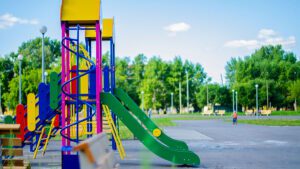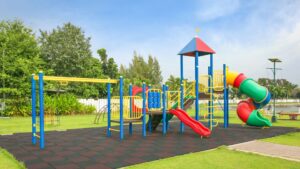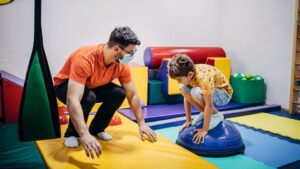A conceção de um parque infantil interior vibrante, seguro e rentável exige mais do que a escolha de conjuntos de jogos. É necessário compreender o mercado, o orçamento, o espaço e as necessidades de desenvolvimento específicas das crianças. Este guia acompanha-o em todas as etapas - desde a avaliação das condições climatéricas e demográficas até à escolha de temas, disposições e equipamento - para que possa criar uma área de recreio interior que faça as delícias das crianças e dos pais.
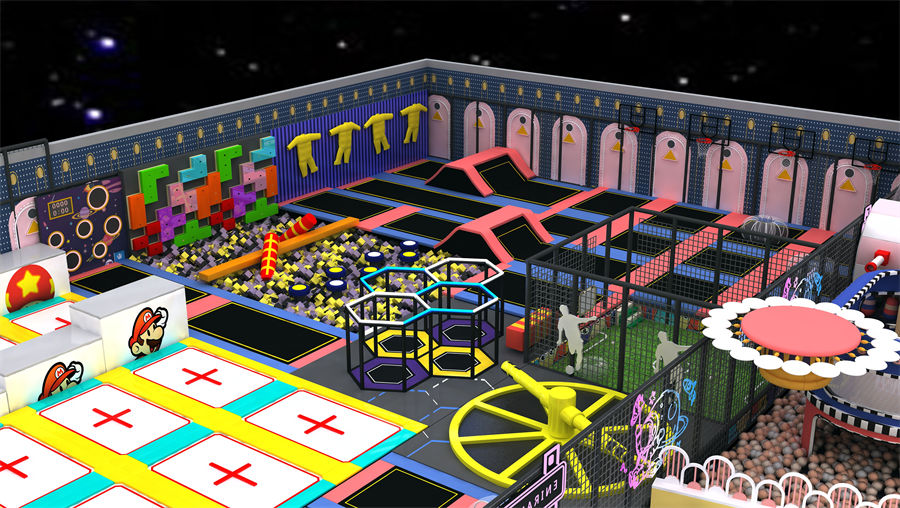
1. É o momento e o local certos?
Antes de investir em equipamento, pesquise estes quatro factores para garantir o êxito do seu parque infantil interior.
1.1 Padrões climáticos
- Durante todo o ano Sol: Em climas consistentemente quentes, as crianças brincam ao ar livre durante a maior parte dos dias, reduzindo a procura de espaços interiores para brincar.
- Climas sazonais: As regiões com Invernos frios ou estações chuvosas aumentam a necessidade dos pais de uma opção de interior.
1.2 Dados demográficos locais
- Densidade familiar: Utilize os dados dos censos ou inquéritos locais para confirmar uma elevada concentração de agregados familiares com crianças pequenas.
- Repartição por idades: Adapte o seu equipamento ao grupo etário dominante - crianças (1-4), crianças em idade escolar (5-12) ou misto.
1.3 Eventos comunitários
- Festas de aniversário e alugueres: Posicione o seu espaço como um local de aniversário, local de excursão escolar ou centro de actividades pós-escolares.
- Necessidades especiais e aulas: Ofereça horas de funcionamento sensorial ou aulas de ginástica para pais e filhos para alargar o interesse.
1.4 Fitness e competição
- Opções existentes: Analisar centros de fitness concorrentes, parques de trampolins ou parques infantis ao ar livre na zona.
- Ponto de venda único: Talvez se concentre em jogos educativos, pistas de obstáculos ao estilo ninja ou uma zona de jogos suaves para crianças.
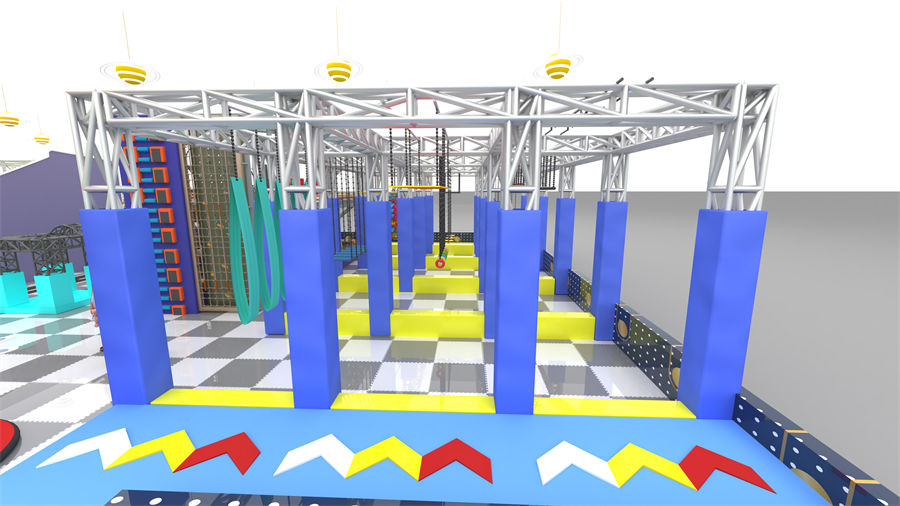
2. Orçamentação e financiamento
Um orçamento sólido protege contra derrapagens de custos e mantém as suas instalações rentáveis desde o primeiro dia.
2.1 Fórmula do custo por criança
- Norma do sector: Atribuir cerca de $1.000 por criança prevista na capacidade da hora de ponta.
- Exemplo: Para 100 crianças, planear $100.000 em custos de equipamento.
2.2 Tema e personalização
- Conjuntos temáticos: Os gráficos personalizados ou as fachadas com carácter aumentam o atrativo, mas aumentam os custos em 10-20%.
- Modular vs. à medida: Os sistemas modulares permitem poupar dinheiro; os layouts personalizados são mais caros.
2.3 Custos suaves
- Autorizações e seguros: Tenha em conta as licenças de construção locais, as inspecções de segurança e a cobertura de responsabilidade civil.
- Pessoal e formação: Planear a integração e a formação contínua em matéria de segurança para os assistentes e supervisores.
2.4 Implementação faseada
- Fase 1: Estruturas centrais (trepadeira, escorregas, fosso para bolas).
- Fase 2 (6-12 meses): Complementos como insufláveis, percursos ninja ou zonas de jogos VR.

3. Planeamento e disposição do espaço
O seu esquema deve equilibrar segurança, fluxo de tráfego e zonas adequadas à idade.
3.1 Altura do teto e área de implantação
- Folga vertical: Pelo menos 12-16 pés para escorregas e paredes de escalada.
- Plano de chão aberto: Mantenha uma distância de 6-8 pés entre as estruturas principais para evitar a sobrelotação.
3.2 Zonagem por idade e atividade
| Zona | Grupo etário | Caraterísticas |
|---|---|---|
| Cantinho das crianças | 1-4 anos | Jogos de espuma macia, mini escorregas, painéis sensoriais |
| Zona de idade escolar | 5-12 anos | Escaladores de vários níveis, pistas de obstáculos |
| Recanto para relaxar e ler | Todas as idades | Sacos de feijão, livros, jogos tranquilos |
| Sala dos pais | Adulto | Lugares sentados, Wi-Fi, balcão de café |
3.3 Linhas de visão e supervisão
- Barreiras reduzidas: Utilize redes transparentes ou paredes baixas para que o pessoal e os pais possam vigiar todas as crianças.
- Check-in central: Posicione o balcão de receção no centro das instalações para facilitar a supervisão.
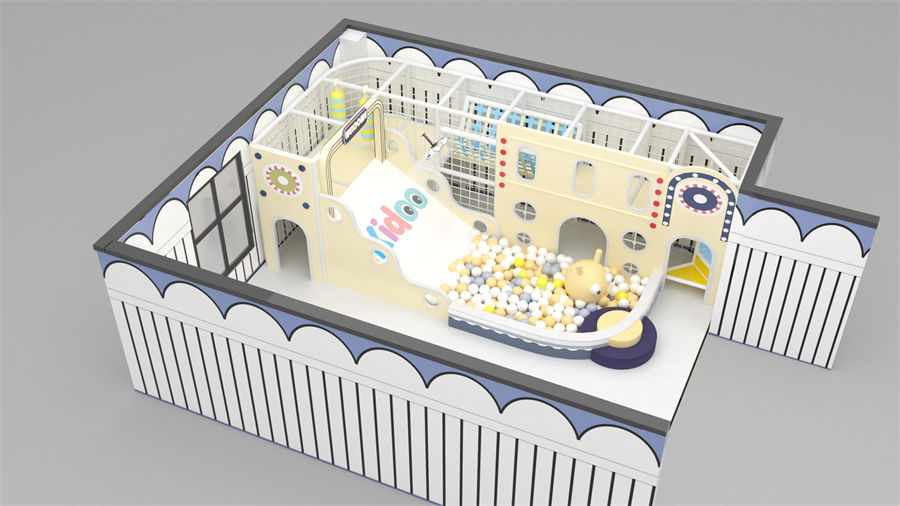
4. Definir o objetivo do seu parque infantil
Esclareça como o seu espaço será utilizado para orientar a seleção e programação do equipamento.
4.1 Exploração segura
- Superfícies antiderrapantes: Ladrilhos de borracha, fibra de madeira projectada ou tapetes de espuma.
- Cantos arredondados: Todos os aparelhos devem cumprir as normas de segurança ASTM e CPSC.
4.2 Brincadeiras criativas e educativas
- Estações de jogo de papéis: Mini mercearias, camiões de bombeiros ou consultórios médicos.
- Painéis STEM: Puzzles simples, engrenagens ou painéis luminosos para despertar a curiosidade.
4.3 Competências sociais e emocionais
- Desafios da equipa: Percursos de obstáculos em grupo ou jogos de cooperação.
- Refúgios tranquilos: Permitir que as crianças se auto-regulem quando estão sobrecarregadas.
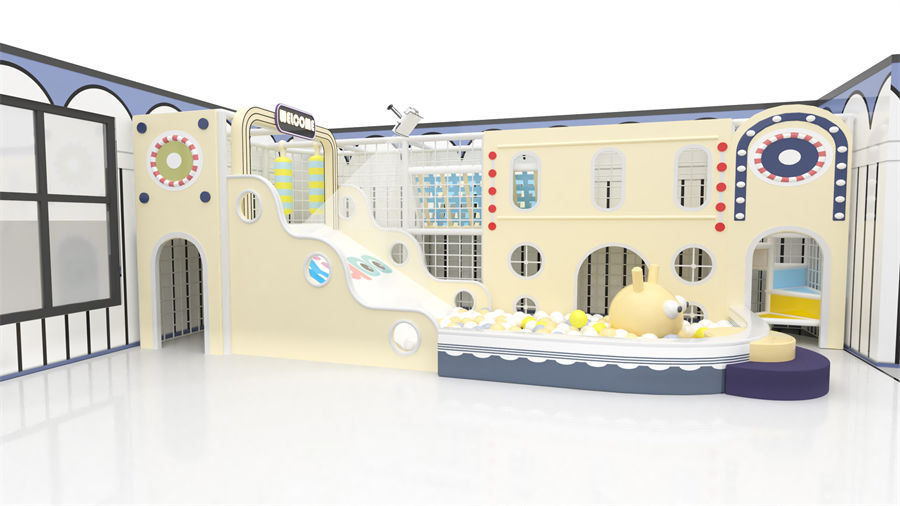
5. Seleção de temas e estética
Um tema coeso torna o seu parque infantil memorável e digno do Instagram.
5.1 Paleta de cores
- Brilhante e contrastante: Utilize cores primárias arrojadas para as zonas mais jovens.
- Neutro e terroso: Tons como o verde suave ou acabamentos em madeira para salas de estar pré-escolares ou familiares.
5.2 Integração da marca
- Cores do logótipo: Faça eco das tonalidades do seu logótipo em murais de parede ou estruturas de jogo.
- Mascotes e ícones: Transforme a mascote da sua marca em suportes de parede em silicone 3D ou em espuma soft-sculpt.
5.3 Gráficos de parede e de chão
- Sinalização: Zonas numeradas ou pegadas de animais que conduzem de zona em zona.
- Murais temáticos: Paisagens da selva, do fundo do mar, do espaço ou da cidade para inspirar a brincadeira de faz-de-conta.
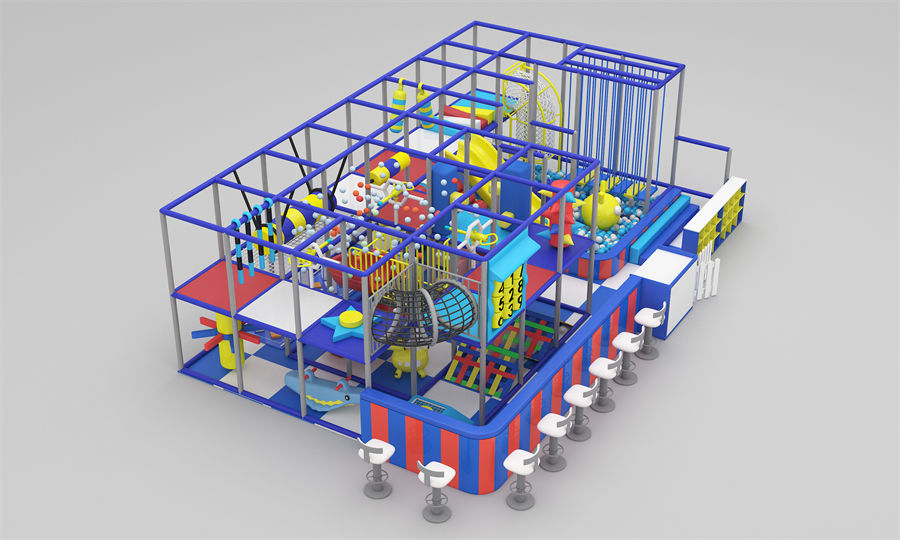
6. Equipamento essencial por idade
A seleção das estruturas de jogo adequadas garante que todas as crianças estão felizes e empenhadas.
| Estrutura | Benefícios | Melhor para |
|---|---|---|
| Armações de escalada | Motricidade grossa, coordenação | Em idade escolar |
| Formas de espuma esculpida macia | Exploração segura, envolvimento sensorial | Crianças pequenas |
| Fosso de espuma | Saltos sem risco, desenvolvimento vestibular | Todas as idades |
| Zona de trampolins | Aptidão cardiovascular, equilíbrio | Idade escolar, Adolescentes |
| Obstáculo/Guerreiro Ninja | Agilidade, resolução de problemas | Idade escolar, Adolescentes |
| Aldeias de jogo de papéis | Competências sociais, jogos imaginativos | Pré-escolar, idade escolar |
| Painéis sensoriais | Estimulação tátil e auditiva | Crianças pequenas |
| Paredes de jogos interactivos | Desafios cognitivos, competição em grupo | Em idade escolar |
7. Segurança e manutenção
Um parque infantil limpo e bem conservado faz com que as famílias regressem e minimiza a responsabilidade.
7.1 Controlos diários
- Peças soltas: Inspecionar os parafusos, a tensão da rede e os escorregas quanto a fissuras.
- Limpar as superfícies: Limpar as áreas de maior contacto com desinfetante seguro para crianças.
7.2 Auditorias semanais
- Integridade do pavimento: Assegurar que os ladrilhos de espuma ou o revestimento de borracha permanecem nivelados e sem deformações.
- Desgaste do equipamento: Procure cordas desgastadas, tinta desbotada ou lascas.
7.3 Inspecções profissionais trimestrais
- Integridade estrutural: Contrate um inspetor de parques infantis certificado para verificar se existem riscos ocultos.
- Certificação de segurança: Manter registos de conformidade com os regulamentos ASTM, CPSC e locais.
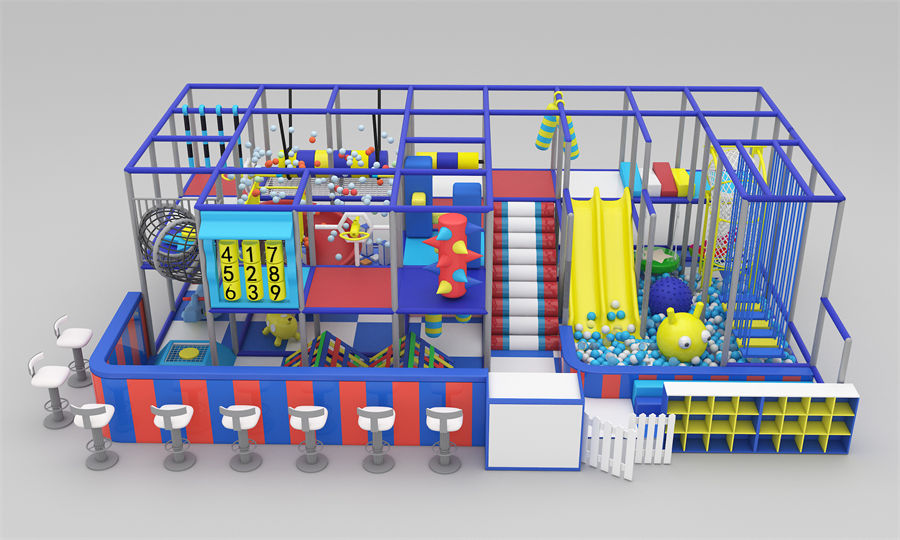
8. Pessoal e programação
O pessoal simpático e formado e os programas envolventes transformam o seu parque infantil num centro comunitário próspero.
8.1 Formação de assistentes
- Primeiros socorros e reanimação cardiorrespiratória: Certificação obrigatória para todo o pessoal da linha da frente.
- Supervisão de crianças: Estratégias de gestão de multidões e de resolução de conflitos.
8.2 Actividades programadas
- Hora do conto e da música: Eventos em zonas tranquilas para crianças pequenas e pessoas que cuidam delas.
- Desafios temáticos: Noites Ninja" ou "Aventuras de Piratas" semanais para incentivar visitas repetidas.
8.3 Adesão e fidelização
- Passes mensais: Acesso ilimitado para visitantes frequentes.
- Pacotes de aniversário: Menu escalonado de complementos de festa (pizza, sacos de brindes, anfitrião dedicado).

9. Comercializar o seu parque infantil coberto
Um marketing eficaz garante que o seu parque infantil coberto se mantém no topo das preferências das famílias e dos organizadores de eventos.
9.1 Presença digital
- Website optimizado para SEO: Inclua palavras-chave como "parque infantil coberto perto de mim", "área de jogos coberta".
- Redes sociais: Partilhe fotografias, testemunhos de famílias e eventos futuros no Instagram e no Facebook.
9.2 Divulgação na comunidade
- Parcerias escolares: Oferecer descontos em programas pós-escolares.
- Eventos locais: Patrocinar feiras comunitárias ou organizar dias de jogos de beneficência.
9.3 Comentários e listagens em linha
- Google My Business: Mantenha os horários, fotografias e informações de contacto actualizados.
- Blogues e diretórios sobre a parentalidade: Incentive as famílias satisfeitas a deixarem comentários positivos.
A conceção de um parque infantil coberto requer uma análise cuidadosa da procura do mercado, das restrições orçamentais, do planeamento do espaço, das normas de segurança e dos elementos temáticos. Ao dividir as áreas por idades, selecionando equipamento adequado à idade e mantendo controlos de segurança rigorosos, criará um destino interessante e rentável que as famílias irão adorar, faça chuva ou faça sol.
Pronto para começar a planear? Utilize as listas de verificação e as sugestões deste guia para dar vida à sua visão e veja o seu centro de jogos interior tornar-se no local preferido da comunidade para a família!

